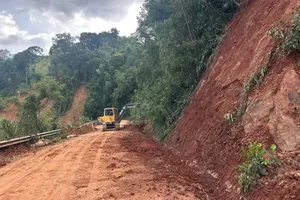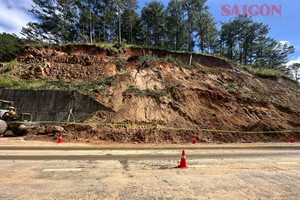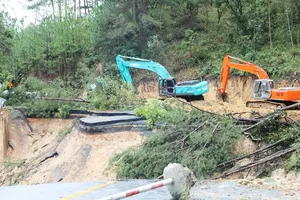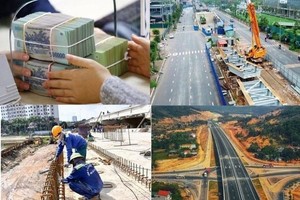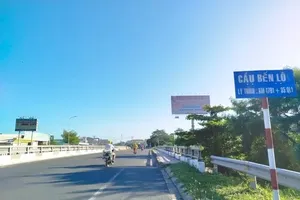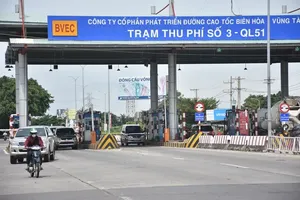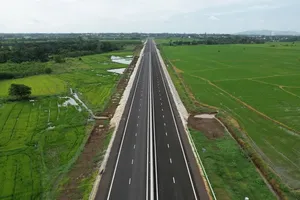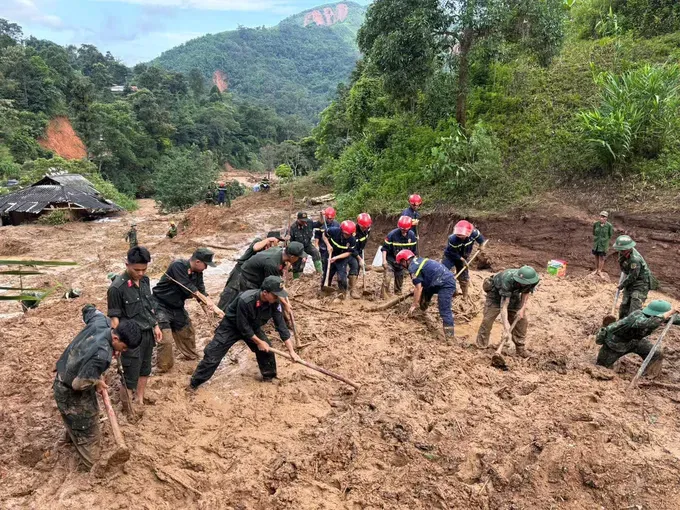
Lurking dangers on roads
Statistics from the Vietnam Department for Roads reveal that the onslaught of heavy rains triggered by storms and tropical depressions has inflicted significant damage on the nation’s highway system since the start of the year. In the wake of the recent Storm No. 3 alone, reports from July 29 indicated that nearly 200 locations across the road network were rendered impassable due to landslides.
This precarious reality underscores the urgent need for more synchronized, long-term, and systematic investment to minimize damage and keep the nation’s economic arteries flowing amidst the complex evolution of natural disasters.
A case in point is National Highway 4G in Son La Province, with severe slope failures blocking traffic for days. It’s a similar story in Nghe An Province, where storms triggered landslides at 140 locations along its main highways. For drivers, routes like the vital National Highway 6 connecting to Hanoi and National Highway 70 in Lao Cai Province have become a perennial source of anxiety. These roads are reportedly plagued by dozens of vulnerable landslide spots, creating high-risk zones of congestion and flooding each rainy season, making travel a dangerous gamble for many.
Deputy Director Nguyen Thanh Hoai of the Vietnam Department for Roads explained that the Ministry of Construction, his agency, and other road management bodies have dispatched multiple inspection teams to localities. Their mission is to immediately address vulnerable points at risk of landslides, flash floods, and inundation, particularly on critical routes such as the North-South railway, National Highway 1A, the Ho Chi Minh route, and highways leading to the Northwest and Central Highlands.
In the maritime sector, the Ministry of Construction has rolled out a national response plan for vessel accidents. Search and rescue ships have been strategically positioned in high-risk areas like Hai Phong City, Nghe An Province, Da Nang City, Nha Trang City, and Vung Tau Ward of HCMC, ready to deploy for any emergency at sea during the 2025 storm season.
Despite concerted prevention efforts by the Vietnam Department for Roads, Vietnam Railway Authority, and Vietnam Maritime and Waterway Administration, the toll on transport infrastructure from storms and rain hasn’t abated. Many locations continue to suffer from recurrent flooding and landslides each year, meaning the threat to traffic safety remains an ever-present danger on every journey.
Fortifying weakest links
According to Nguyen Thanh Binh, a permanent member of the Ministry of Construction’s Command Committee for Disaster Prevention and Search and Rescue, Vietnam lacks sophisticated early-warning systems for landslides and flash floods.
This danger is compounded by rampant deforestation and widespread illegal activities like land leveling and dumping waste into drainage channels. He explained that this chokes water flow, leading to localized flooding that severely damages road infrastructure—a critical problem that authorities have yet to effectively curb, leaving many areas vulnerable each rainy season.
To tackle these issues, the Ministry of Construction has petitioned the government to prioritize fortifying vulnerable railways and mountainous highways crippled by landslides. It has also formally requested funds for larger, long-range maritime Search and Rescue (SAR) vessels to enhance offshore operations.
Looking to the 2026-2030 period, Deputy Minister Le Anh Tuan outlined a vision centered on technology. The plan includes digitalizing disaster prevention efforts, investing in modern forecasting equipment for more accurate predictions, and bolstering personnel training. The ministry also aims to expand international cooperation to improve its overall response capabilities.
Call for more precise forecasts
The Ministry of Construction highlights a key regulatory challenge at sea. While certain coastal vessels can only operate in fair weather, official marine forecasts are too broad, often covering several provinces at once. Authorities must use the worst-case prediction for the entire region to issue permits. Consequently, countless vessels are unnecessarily grounded even when their local conditions are perfectly safe. This flawed system creates severe logistical bottlenecks and substantial financial losses for the coastal transport industry, especially during the peak storm season when the economic impact is most acute.
The Ministry of Construction has formally proposed that the National Center for Hydrometeorological Forecasting issue hyper-local, near-shore forecasts. The ministry argues this would enable smarter operational decisions and enhance maritime safety.
Also, imprecise forecasts are currently straining rescue systems, forcing port authorities and rescue services into a reactive posture. These agencies are left scrambling to guide vessels to safe anchorage during storms, highlighting the urgent need for more accurate, proactive data to ensure safety on the water.
Both the Ministry of Construction as well as the Ministry of Agriculture and Environment agree that amid increasingly complex weather patterns, enhancing the quality and detail of near-shore marine forecasts is crucial. It won’t just help vessels operate more safely; it will also significantly reduce the immense burden on emergency response and traffic management systems.
The coastal information station network is another key player in the maritime disaster response system. These stations maintain a vigilant 24/7 watch, continuously broadcasting warnings and tracking data on storms to steer vessels away from danger zones. From November 2023 through the end of 2024, the system handled 1,112 distress calls and supported 237 rescue incidents, assisting 427 Vietnamese vessels, 572 foreign ships, and a total of 1,143 people at sea.
The Vietnam Maritime Search and Rescue Coordination Center maintains a rescue fleet at high-risk locations. Over the past year, its forces have saved over 1,000 people. These figures don’t boast success but underscore the immense pressure on rescue teams, worsened by a forecasting system that fails to meet industry needs.
For Head Tran Van Phu of the Management Board for Nha Trang City’s 300+ tourist vessels, safety is a daily concern. Spurred by a recent capsizing in Ha Long Bay and unpredictable storms, his office has significantly tightened protocols for the bay’s many high-speed canoes. Operators now face mandatory, rigorous pre-departure safety checks and a strict no-sail policy during adverse weather conditions. He emphasized that all decisions must prioritize safety, requiring operators to be proactive in moving vessels to shelter at the first sign of danger.
